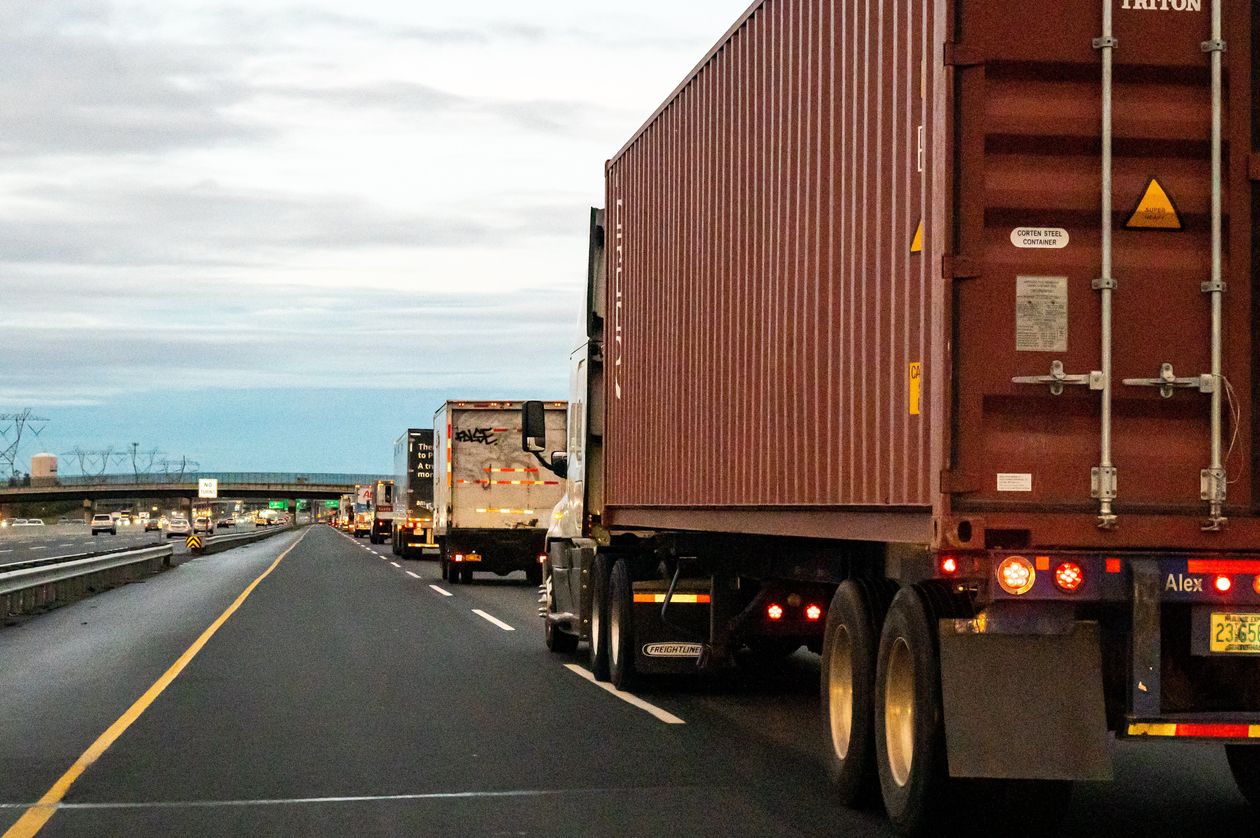Truck driver Chris Wagner pulled his big rig into a grain processing plant in Sidney, Ohio, on a recent afternoon to pick up a load bound for the Chicago suburbs. He’d lost his scheduled place in line because of delays at an earlier delivery, so it was 10:45 p.m. before the plant was ready to load his trailer.
By then, the clock had run out on his federally mandated 14-hour workday, so Mr. Wagner couldn’t pull up to the dock. He slept that night in his truck on the plant’s lot and left empty-handed the following morning, unable to reschedule the pickup.
“I sat overnight and still never got loaded,” said Mr. Wagner, a 53-year-old retired Marine from Lena, Ill., who drives for Quality Transport Co., a small trucking operator based in nearby Freeport.
A critical, often-overlooked link in the supply chain is emerging as a stubborn choke point in the freight-backlog mess: trucking.
Trucks haul more than 70% of domestic cargo shipments. Yet many fleets say they can’t hire enough drivers to meet booming consumer demand as the U.S. economy emerges from the pandemic.
The freight backup has intensified longstanding strains in the industry over hours, pay, working conditions and retention.
The surge of goods has created logjams at loading docks and port terminals, gobbling up scarce trucking capacity and making drivers’ jobs even harder. Factories and warehouses are also short of staff to load and receive goods. Meanwhile, the broader labor shortage has left openings for other blue-collar jobs that compete with trucking, including in local delivery operations, construction and manufacturing.
The shortfalls are pushing up transportation costs and delaying deliveries for retailers and manufacturers already coping with disruptions ahead of the holiday peak.

A line of trucks travel south on Interstate 95 in New Jersey.
Photo: Desiree Rios for The Wall Street Journal
The American Trucking Associations, one of the largest trade bodies, estimates the industry is some 80,000 drivers short of the workers needed to keep goods moving freely this year—up from an estimated shortage of 61,500 drivers before the pandemic. New trucks, trailers and other equipment are in short supply, further limiting the movement of cargo.
Trucking payrolls have rebounded from early pandemic lows when efforts to stop the spread of Covid-19 shut down much of the economy. The sector added 74,500 jobs between April 2020 and September 2021, according to seasonally-adjusted Labor Department data, though overall employment in trucking remained 1.3% lower than pre-pandemic levels in September 2019.
To help draw more drivers, fleets of all sizes are raising wages and dangling bonuses. The American Trucking Associations is backing proposed legislation to test letting people as young as 18 drive big rigs interstate, a job now limited to drivers 21 and older. Close to a third of drivers now on the road are over age 55, and women make up only 7% of all truckers, the group said. Median annual pay for heavy-truck and tractor-trailer drivers last year was $47,130, according to the Bureau of Labor Statistics, and has increased by about 3% to 4% annually since 2016.
Some operators say the biggest problem isn’t a shortage of drivers, but a lack of efficiency in a model that hasn’t changed much in several decades.
Many drivers are paid by the mile, and typically don’t get paid for the first two hours spent waiting to load or unload cargo. Even after that window, drivers often don’t routinely seek compensation from carriers or freight brokers for that time because they seldom get it, according to a 2020 survey by the Owner-Operator Independent Drivers Association. Any pay for time spent waiting is generally less than what drivers would make when their wheels are rolling.
“The economic dysfunction of trucking is there’s no value placed on a driver’s time,” said Todd Spencer, president of the association, which represents drivers that own or operate individual heavy-duty trucks and small truck fleets.
Now, truckers who used to wait a few hours to pick up or unload cargo sometimes sit as long as 12 hours, said Daniel Faircloth, chief executive of Surge Transportation Group LLC, a Dallas-based carrier with 75 trucks.
To address that, Mr. Faircloth raised the rates he charges his shipping customers and offered to pay his drivers a straight salary of $1,650 a week. “Inefficiency in the entire industry gets under drivers’ skin,” he said. “You help us get more efficient, and that helps drive rates down.”
In September, the average cost to hire a big rig on the “spot market,” where companies book last-minute transportation, was $2.49 per mile excluding fuel surcharges, up 14% from the same month in 2020, according to online freight marketplace DAT Solutions LLC. It’s the highest monthly average since DAT began reporting that data in 2010. The average price for the long-term contract rates shippers negotiate with trucking companies jumped 23%, to $2.49 per mile, also a new high.
Sadaya Morris, a 28-year-old driver from Plainfield, N.J., used to run loads as an independent contractor for a port trucking company. She started her own business under the name Pink Transportation LLC in September 2020 and can now bid for freight herself, a move she says will improve her earnings.
Ms. Morris said drivers often sit for hours waiting to pick up cargo from the Port of New York and New Jersey, only to get held up again when dropping off freight with customers.
“It’s the operations that are the issue,” said Ms. Morris, who belongs to a trucker group called PAR18 that is pushing to ensure port drivers get paid for their time. “We’re obligated to wait there for two hours for free.”
In California, where cargo is piling up at the bottlenecked ports of Los Angeles and Long Beach, recruiting additional drivers has been an uphill battle, said Lisa Wan, director of operations for RoadEx CY Inc., a Carson, Calif.-based operator that hauls cargo from ports to local yards and distribution facilities.
The surge of freight has left port truckers who make those short runs tired and burned out, she said. As of September, import volumes at the ports of Los Angeles and Long Beach were 25% higher year-to-date compared with the same period in 2020.

Ronal Giron moves containers at the RoadEx headquarters yard in Carson, Calif.
Photo: Allison Zaucha for The Wall Street Journal
Some port truckers who make those runs have switched to become long-haul drivers, who move freight over a distance of 250 miles or more, as rates to move goods out of state have skyrocketed, Ms. Wan said.
Other drivers have turned to local delivery work, which doesn’t typically involve overnights on the road, or left the industry altogether, opting for jobs with more predictable hours.
Jesse Milligan of West Lafayette, Ohio, is a third-generation trucker who started driving in 2009, after he got laid off from a steel mill. He hauled lumber, chemicals and military vehicles all over the country with his father, who owned his own truck, then bought the vehicle and went into business for himself.
He took a local job in September last year delivering and installing propane systems to spend more time with family. The pay is on the lower end of what he used to make, at around $50,000 a year, he said, but he gets home every night. With long-haul trucking, “you need to be on the road a couple of weeks at the time,” said Mr. Milligan, 37. “It’s just too hard with kids to plan anything.”
Carriers on average will end up paying drivers about 8% more this year, according to the National Transportation Institute, a research group that benchmarks trucking industry wages. Pay varies widely, with some truckers earning $45,000 a year while drivers for private fleets that move goods for manufacturers or retailers can make well over $100,000 a year, NTI Chief Executive Leah Shaver said.
The ATA said pay increases mean some drivers will choose to work less at higher rates, further denting capacity.
“If they can make in two or three days what would normally take them a week, they’ll go home,” said Jerry Gioia, an owner-operator with a four-truck fleet based in Hayden, Colo.
Big trucking companies warn that the transportation problems, and higher rates, could extend into next year due to labor and equipment shortages and the backlog of freight.
“Really, it’s all about drivers,” Eric Fuller, chief executive of US Xpress Enterprises Inc., a large Chattanooga, Tenn.-based trucking company, told investors in an Oct. 21 earnings call. “We can’t find enough people that want to do the job.”
Many long-haul drivers say that although they like the freedom of driving on the open road, truckers often quit because of low pay and poor treatment by both employers and customers.
Tyler Foster, 53, a long-haul driver from Green River, Wyo., said that some big trucking companies treat workers like they’re expendable. “They just run them hard, they get very little pay and they leave after three to six months,” he said.

Trucks leave Long Beach Container Terminal at the Port of Long Beach in Southern California.
Photo: Allison Zaucha for The Wall Street Journal
Some customers aren’t much better, Mr. Foster and other truckers said, and make drivers wait hours for freight under conditions that have gotten worse since businesses added restrictions aimed at curbing the spread of Covid.
“The shippers, they treat us like criminals, basically. Don’t use the bathroom, don’t get out of your truck,” Mr. Foster said. “The port-a-potty’s in the yard, but it’s 25 degrees out.”
Some companies are working with carriers to address those problems by streamlining the way they receive freight and keeping facilities like bathrooms and waiting rooms open to drivers, said Gail Rutkowski, executive director of the National Shippers Strategic Transportation Council, which represents transportation professionals at businesses that ship and receive goods, including retailers, manufacturers and distributors.
Drivers and fleet owners also say that government regulations can be intrusive or cut into driver earnings, pushing some to leave. Those include rules intended to reduce fatigue by electronically tracking drivers’ time behind the wheel, or to curb pollution near the ports of Los Angeles and Long Beach by phasing out the use of older trucks.
Some truckers say that a number of California drivers have either left the state or taken other jobs because of a 2020 law that seeks to require companies there to classify independent contractors as employees. The California Trucking Association has said that the measure would essentially ban a common industry practice and harm independent truckers that haul freight for trucking companies operating in California. The association has asked the U.S. Supreme Court to review a case challenging its application to trucking.
Steve Viscelli, a sociologist at the University of Pennsylvania who studies the industry, said that trucking’s hiring challenges largely stem from a labor model that churns through inexperienced drivers.
“There is absolutely not a shortage of people licensed and trained to do that job,” Mr. Viscelli said. “The industry has burned so many of them that they left.”

A mix of empty and loaded shipping containers fills the yard at RoadEx.
Photo: Allison Zaucha for The Wall Street Journal
In California, more than 468,000 people hold Class A commercial driver’s licenses, allowing them to operate vehicles including heavy-duty trucks and tractor-trailers, according to June data from the state’s department of motor vehicles. Mr. Viscelli estimated that less than half that number are working in jobs in the state requiring that license, and said nationally there are millions more people certified as commercial drivers than are currently working as truckers.
“If we wanted to add capacity quickly,” he said, “the big question is how to get people to come back?”
Reducing on-the-job hardships, such as a lack of parking and extended wait times, would help make the job more rewarding for drivers, said David Heller, vice president of government affairs for the Truckload Carriers Association.
“If you lower those waiting times to the minimum amount that you needed to do, all of the current existing drivers could haul more freight, which essentially means you increase effective capacity without adding one truck,” ATA Chief Economist Bob Costello said.
Jim Orr, a 65-year-old independent trucker from Chandler, Okla., doesn’t take loads from customers who keep him waiting. He rarely works more than 500 miles from his home, and doesn’t have much sympathy for businesses that complain about high trucking rates.
That’s capitalism, Mr. Orr said. “I’m sure they weren’t concerned two years ago when we were lucky to be getting half of what we are now. It’s the market…feast or famine.”

Trucks at the Port of Los Angeles.
Photo: Allison Zaucha for The Wall Street Journal
Write to Jennifer Smith at [email protected]
Copyright ©2021 Dow Jones & Company, Inc. All Rights Reserved. 87990cbe856818d5eddac44c7b1cdeb8








